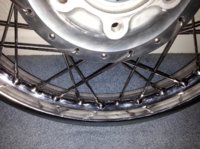CalsXS2
XS650 Guru
- Messages
- 1,006
- Reaction score
- 52
- Points
- 48
I don't know what all the fuss is about spokes. I got it right the first time. And I didn't even look at any pictures or anything.
I hope you figured out by now that I'm full of shit with that last statement. I'm ashamed to admit how many tries it took me. Lets just say it was more than one.
I'm ashamed to admit how many tries it took me. Lets just say it was more than one. 
Please tell me I got it right.
I hope you figured out by now that I'm full of shit with that last statement.
 I'm ashamed to admit how many tries it took me. Lets just say it was more than one.
I'm ashamed to admit how many tries it took me. Lets just say it was more than one. 
Please tell me I got it right.




 I was getting the spacing right. But I wasn't clocking it far enough around I guess. I kept ending up with what I thought were too long of spokes. And the outer spoke beauty mark on the hub was not matching up.
I was getting the spacing right. But I wasn't clocking it far enough around I guess. I kept ending up with what I thought were too long of spokes. And the outer spoke beauty mark on the hub was not matching up.

